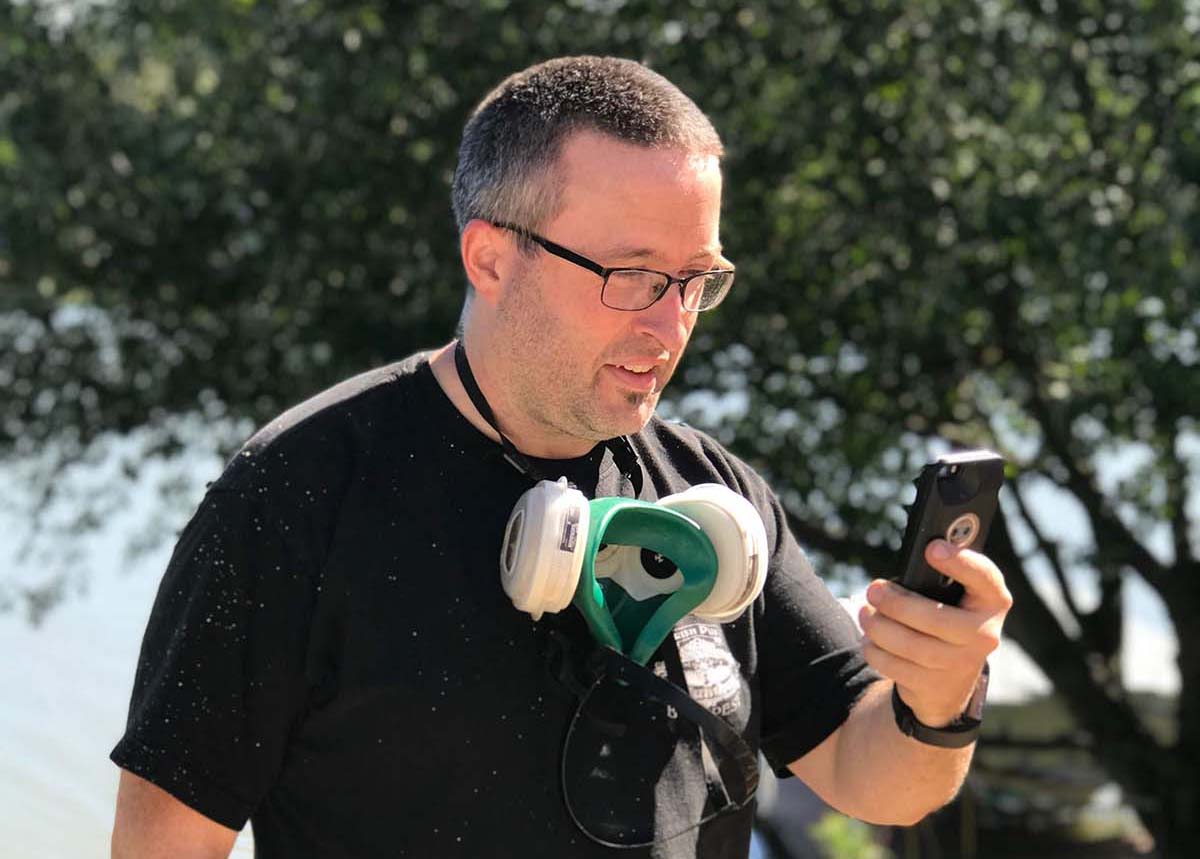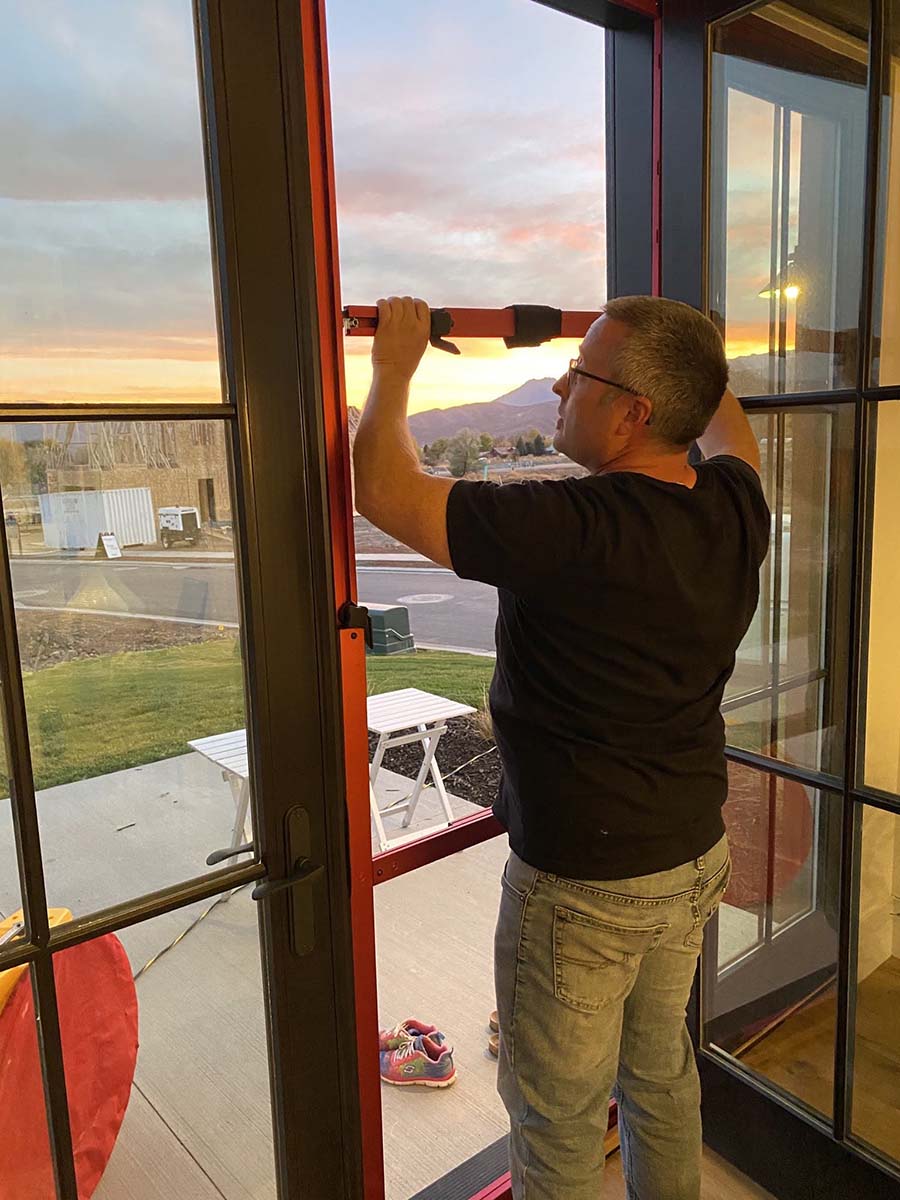Nate Adams has a curious mind.
He’s been that way since his youth, watching intently as his father carefully restored high-end, antique cars. While not the mechanical savant his father was, he enjoyed tooling around underneath hoods as a kid.
These investigative endeavors further bloomed as he learned — and continued to challenge — the concepts of home performance later in life.
It’s that inquisitiveness that’s led him; his wife, Rachel; daughter, Felicity; their truck; dogs, Luther and Bandit; and a camper from West Virginia to the Greater Denver area in search of another dimension.
“We’re here to visit this place called Convergence Station — it’s like stepping into another world,” said Adams, from behind his steering wheel, his words bouncing with excitement. “It’s like a museum where every room is created by different artists, and they’re all connected in a central space through these wormholes. It’s a very surreal, colorful, alien-like experience — inside, I feel like I’m 6 years old again — and it’s been a long time since I was 6 years old!”
The Adams family hopes to assemble its own “immersive art” experience someday soon near their West Virginia residence, deeming the trip equal parts rest, relaxation, entertainment, and research.
“I come from a family of artists, yet I’m not traditionally artistic,” he said, abjectly. “So, it’s only fitting I married an artist. Rachel really enjoys these experiences, so we built our trip around visiting immersive experiences.”
Despite his artistic humility, by all measures, Adams is a comfort savant. Though, instead of painting in shapes and hues, he creates using a canvas sprawling with heat pumps, insulation, and spray foam; his strokes measured in cfm, Btu, kWh, and pints of moisture.

DOUBLE CHECKING: Nate Adams inspects a spray foam job with a Flir One infrared camera after the roof was removed. This lanai is far easier to heat and cool now.
A Shift in Gears
Following in his dad’s footsteps, Adams was figuratively born with a wrench in his hand. At the age of 12, he could identify every car on the road simply by its tail lights. He’d memorized each model and make’s horsepower and zero-to-60 times, reciting them on demand.
Of all the cars that donned his family’s garage, his personal favorite was a 1989 Ford Thunderbird Super Coupe, which he regularly pushed to its extreme limits.
Naturally, in 1994, he joined his father’s automotive business, helping to sell thin wall steel rack and pinion steering sleeves and, later, the “Bone Creeper,” a wheeled apparatus designed to grant mechanics access to cars’ undercarriages. After 10 years of family ups and downs, and promotions ranging from floor sweeper to vice president, Adams decided it was time to try something new.
“My dad wanted me to do everything,” he said. “And I was dumb enough to try. Ultimately, things didn’t end up working out.”

GENERATIONAL TALENT: Nate Adams in 2001 with his father Dale Adams leaning on a 1926 Rolls Royce Dale designed and built a new body for in front of the 1928 L.N. Gross Co. building Dale did restorations in. (Courtesy of Chris Coville)
Breaking Away From the Family Business
In July 2005, Adams joined Guardian Building Products as a territory manager, selling fiberglass insulation. This served as his introduction to building science, which, sparked his everlasting curious itch.
“I absolutely fell in love with homes and buildings and how they function,” he said. “The concepts were focused on results, which truly piqued my interest.”
From inside sales to outside sales, Adams was making an impression within the company. In less than four years, he’d grown his territory from $400,000 to more than $2.75 million.
And, then, an economic collapse crippled the industry.
“My job evaporated with the housing crisis,” he said. “It was ugly. The recession limited opportunities — every job posted was receiving 400-500 resumes. I needed to find a way to make money quickly.”
With housing starts stuttering to historical lows, in 2009, Adams started a retrofit insulation company so he could make money on day one.
“The work I was doing sucked,” he said. “I didn’t know any better, just like most starting off in the trades.”
Around 2010, Adams met Karl Balla, an energy auditor, who quickly became a mentor. Balla’s team would perform an energy audit and then call Adams in to complete the insulation work. Through this process, Adams would pester Balla with questions, soaking up information like a sponge.
“Between Karl and BPI [Building Performance Institute] training, I went from not understanding much of this stuff to learning it very quickly and wanting to do all of it as frequently as I possibly could.”
Adams’ fascination got the best of him, and he quickly found himself endlessly over-delivering on every job, destroying any and all profit margins.
“I’d built this treadmill, and I kept turning up the speed,” he said. “Despite its importance to the comfort equation, there’s a reason that no large retrofit insulation contractors exist — it’s simply not profitable enough.”
Despite his best intentions, Adams’ obsession pushed him beyond the brink of professional and personal exhaustion.
“I was working 80-hour weeks for little more than minimal pay,” he said. “My wife was begging for my attention. At one point she asked, ‘Can I have one evening alone with you? Just one.’ And I told her no.”
Writing the Book on Home Performance
In 2013, Adams, who’d recently become a father for the first time, knew something had to give. Yet, his curiosity continued to drive him forward. One question continued to ring loudest: “How do I actually solve problems and make a living without killing myself?”
Around this time, Adams met Ted Kidd, who shared with Adams that his average job was around $16,800. By contrast, Adams’ average job was around $2,500.
“Those numbers certainly got my attention,” he said.
Kidd and Adams joined forces, developing a repeatable process that holistically solved clients’ home comfort problems, which they showcased on the Energy Smart Ohio website. Finally, business was good, and things were looking up.
During his downtime, in 2015-2017, Adams began drafting a journal full of home performance solutions, which evolved into “The Home Comfort Book.”

FULLY INSULATED: Nate Adams is covered in cellulose insulation when dense-packing the walls of a home. (Courtesy of Nate Adams)
“In the home performance world, there is a ton of 301- and 401-level information, but very little 101-level information to help techs connect the ‘what to the why,’” he said. “I wrote the book I wish I had years earlier.”
Around this time, Adams also unveiled a new moniker “Nate the House Whisperer,” evolving into a teacher, aiming to share the knowledge he’d accumulated over the last 12 years.
“The curse was, doing 10-20 jobs per year doesn’t move the needle,” he said. “More good jobs than bad need to be done to move the needle. How does that happen?”
In response, Adams and Kidd shifted to figuring out a way for HVAC contractors to deliver true comfort without putting themselves out of business.
HVAC 2.0
Amidst the pandemic, Adams set out to reinvent the home performance wheel, introducing the HVAC 2.0 technical sales process.
“From a sales approach, this is unlike anything else in the industry,” he said. “Most everything else starts on the easy stuff, while we’re working in the other direction. We’re starting with comprehensive retrofits and working backward to simple replacements.”
HVAC 2.0, per Adams, is a business model designed to help every client find the best solution for them, from simple to complex, while making it fun for both sides.
Through the process, if clients only need a simple replacement, they receive simple education on their options, but, if they have more complicated problems, there are paths to solve those as well, he said.
“For years, we said, ‘Prescription without diagnosis is malpractice,’ but, the fact is, few want to pay for a diagnosis,” he said. “How could we still help those clients without promising things we couldn’t be sure to deliver? Thus, the free quote process was born.”

LEAKAGE TEST: Nate Adams installs a blower door in a Utah home to test how leaky it is. This new 3000 square foot home is heated with a 3 ton heat pump. (Courtesy of Nate Adams)
Many times, solutions include a heavy dose of heat pumps, which Adams has become a huge proponent of.
“When you start running loads that are truly accurate, and you really understand what's going on, you’ll find that every house would be best served with a heat pump — it's just a matter of which backup heat source you choose,” he said. “Heat pumps can vary their outputs much lower than furnaces, providing a consistent and gentle stream of heating or cooling that provides excellent comfort and IAQ. ‘Green’ benefits are just a bonus. Clients are astonished by how much more comfortable their homes are with heat pumps. A consistent refrain is ‘I can’t believe this is the same house!’ Heat pumps really are magical if you use them well.”
#TakeBackHVAC
Going forward, Adams remains dedicated to HVAC 2.0 because he wants contractors to help homeowners find the path that’s truly best for them while both sides have fun and make a good living.
In an effort to cast as wide of a net as possible, he’s currently hosting weekly webcasts throughout social media, exploring topics such as “Going Both Ways: Winning with Heat Pumps,” “Repair Not Replace” “Load Ranges Not Calcs,” and more.
Adams acknowledges there’s a lot of work left to be done, and, as an ambassador for comfort conscientiousness, he doesn’t plan on stopping any time soon.
“It’s time to take back HVAC,” he said, “Because, let’s face it, the average install sucks. NIST research shows the majority of residential HVAC installs — as many as 90% — have detectable faults. According to measureQuick data, approximately 70% of systems have more than a half-inch of static pressure, which is unacceptable.”
Back in Denver, upon his exit from the Convergence Station, the Adams family packs up the truck to continue their adventures out West. Despite the long trek ahead, his focus never wavers, and the questions never stop.
“Bad installs may lead to quick paydays, but they burn goodwill,” he said. “How do we make good work a competitive advantage rather than a disadvantage? How do those of us who greatly value serving customers and displace the bad work that is the norm? We need a consistent and repeatable system where ordinary talent can deliver extraordinary results, that’s what we’re trying to build.”
Pressing the brake, Adams brings the truck to a halt, abiding by the red traffic light ahead. Recognizing the truck is not the old Thunderbird, he eases on the accelerator when the light turns green. Then, he pauses, filling the phone line with silence, a rare occurrence over the course of the hourlong interview conducted for this article. Then, he laughs, and, in conclusion, simply quips: “Any questions?”



Report Abusive Comment